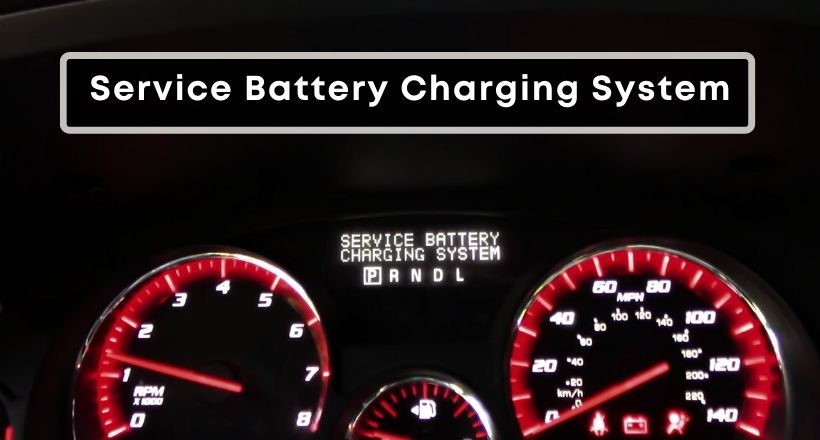Of all the warning messages on GMC Acadia’s instrument panel, the most annoying is the ‘service battery charging system.’
That’s mainly because it occurs in a variety of situations.
Sometimes, you get this warning when trying to start the vehicle, while in other cases, it appears when the engine is already running.
In this post, we’ll discuss all the possible reasons for this problem and different fixes you can apply.
GMC Acadia Service Battery Charging System Reset
There are different ways to reset the service battery charging system warning light in GMC Acadia, depending on whether you’re getting it due to an electrical glitch or some faulty component.
If it’s the former, you can try resetting the ECU by disconnecting the battery terminals or clearing the message through a code scanner.
These procedures will fix the warning message if it’s popping up due to a computer glitch.
However, if there’s a malfunctioning charging system component triggering the message, it’ll reappear.
In such a situation, you’ll have to use the code scanner to find out the exact component that’s causing the problem.
If you have no code scanner, the only option left is to check each component in the charging system, such as the battery, alternator, battery current sensor, etc., one by one.
What is the Car’s Battery Charging System?
Before analyzing this warning message, we need to discuss how car batteries are charged.
In modern non-EV vehicles, the electrical system consists of a battery, a starter motor, an alternator, and a serpentine belt.
Initially, the vehicle’s ignition key is in the off position, and the engine is not running.
When you turn the key to the start position, the battery converts its chemical energy into electrical energy and sends a powerful jolt to energize the starter motor.
The starter motor uses this power to temporarily engage a small gear to the flywheel, which causes the latter to start spinning.
Since the flywheel is connected to the crankshaft, its rotation causes the crankshaft to rotate, resulting in the engine starting.
The alternator is connected to the crankshaft via the serpentine belt. So, when the latter starts running, it causes the alternator to run, too.
The alternator converts the mechanical energy into electrical energy and starts to power all of the vehicle systems, such as A/C, power steering, infotainment system, etc.
It also replenishes the battery to make up for the power it lost while energizing the starter motor.
But if the electrical load from the vehicle systems exceeds the alternator’s output, the battery steps in again to meet the demand.
What Does Service Battery Charging System Mean?
In theory, this warning message means there’s some problem with your battery charging system that’s preventing the battery from getting charged by the alternator.
This is a serious issue because if the battery is not being charged, it will not be able to start the engine next time. As a result, your vehicle will not start, and you might have to jumpstart it.
That said, many Acadia owners have reported that this message appears for no reason. You can confirm if that’s the case through a code scanner.
If there’s no error code generated, it usually indicates an ECU glitch. In such a case, you can try fixing this error by resetting the ECU. All you need to do is to disconnect the negative battery terminal temporarily.
How to Fix GMC Acadia Service Battery Charging System?
If resetting the ECU didn’t fix your issue, it indicates a faulty component in the vehicle’s charging system.
In such a situation, you can use the code scanner to get the relevant code and fix that component.
If you don’t have a scanner, all of these components will need to be checked one by one.
1. Check the Battery
The first component we’ll check is the battery itself.
Most people don’t realize, but even good car batteries only last 3-5 years. After that, they lose the ability to hold the charge, resulting in power drainage.
So, if your car was perfect the night before and the service battery charging system message only popped up the next morning, it’s a good indication that the battery is not holding the charge.
To confirm whether that’s true or not, you’ll need to test the battery.
The first thing you should test is the battery’s voltage.
You’ll need a multimeter for this purpose. Before starting the procedure, make sure the battery’s terminals are clean/corrosion-free and connections are tight.
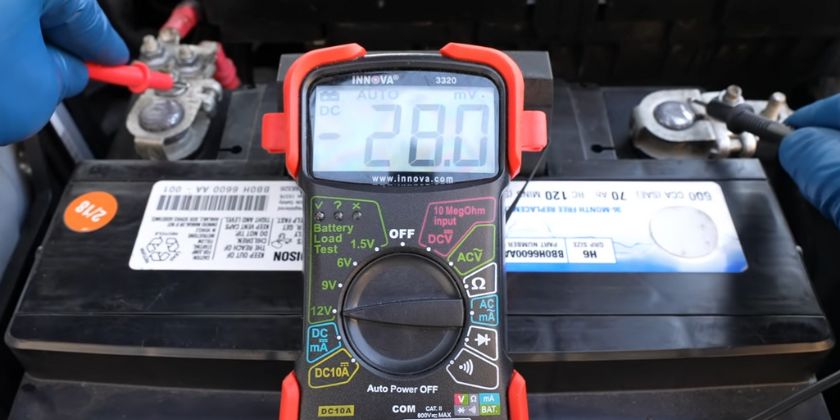
Set the multimeter to 20V DC voltage mode.
Then, connect the negative multimeter probe to the negative battery terminal and the positive multimeter probe to the positive battery terminal.
A healthy battery should give you 12.4-12.6V. Anything less than that, such as 10.5V, indicates the battery is not working.
In such a situation, you’ll have to find out whether the battery is draining or its cell(s) has died.
The car battery charger can help you find this answer. Simply charge the battery through it and then leave it for some time. If the voltage quickly drops to 10.5V, it indicates a dead cell.
In case you’ve got the 12.4V-12.6V reading, the next thing to do is to test the cold cranking amps through a battery load tester.
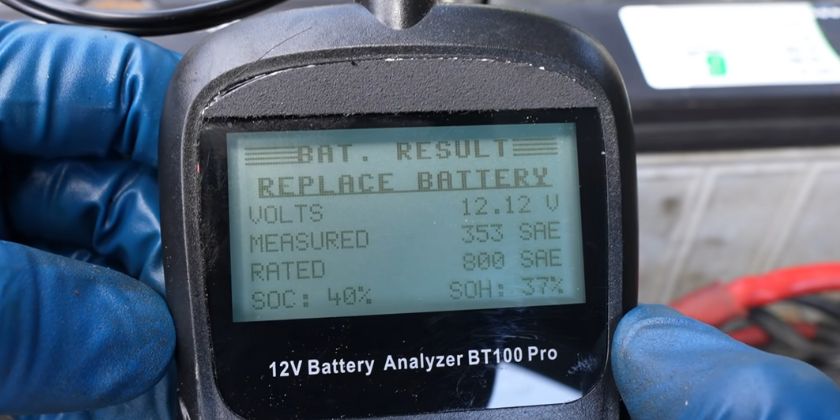
The CCA rating of a battery indicates its ability to start an engine in cold temperatures (usually at 0°F or -18°C) while maintaining the voltage level.
Testing the CCA of a battery involves measuring the battery’s ability to deliver a high current (in amps) for a short period.
That’s because even if a battery shows a full voltage, it may not have enough capacity to provide the high current needed to crank the engine.
I realized it recently when my friend’s car was not starting, even when the battery’s voltage reading was in the normal range.
It turned out that the CCA reading was around 550 Amps, almost 200 Amps less than what that battery was rated at (750 Amps).
2. Check the Alternator
If you’ve tested the battery and it’s working fine, the next component to be checked is the alternator.
That’s because if the alternator is not working, it won’t be able to recharge the battery to make up for the power the latter lost when energizing the starter motor.
As a result, the battery will remain weak, and your vehicle won’t start.
To check whether this assumption is true, you’ll need to start the vehicle and test the battery’s voltage.
When the engine is running, and the vehicle accessories (such as radio and A/C) are turned off, you should get a 13.6V-14.6V reading.
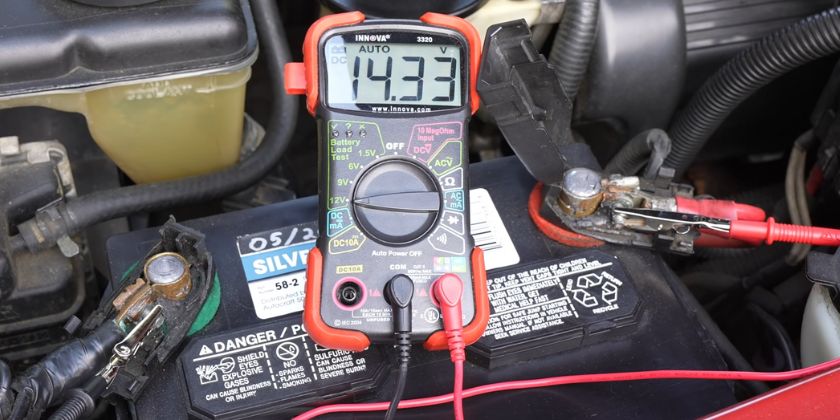
If the reading you get is higher than that, such as 15V, it means the alternator’s voltage regulator is not working and should be fixed.
Similarly, if the reading is less than that, it means either the alternator is dying, or the wire that runs between the alternator and the battery is damaged.
To find out the exact reason, we’ll need to check the voltage at the alternator.
Connect the positive multimeter lead to the alternator’s output terminal and the negative terminal lead to the alternator’s outer casing, as shown in the picture.
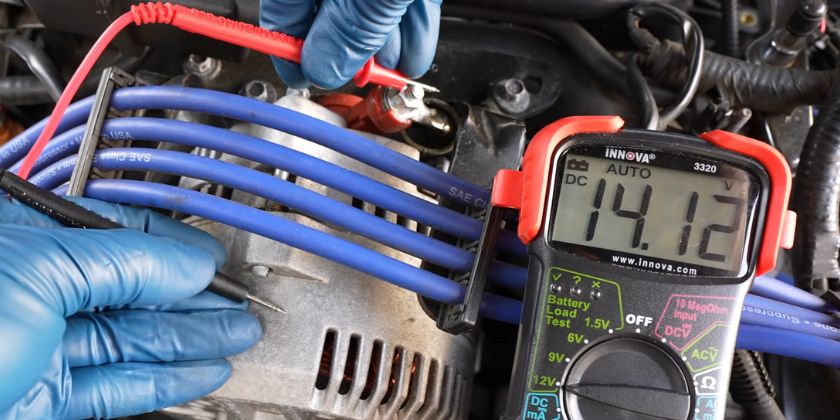
If the reading is higher (13.6V-14.6V), it means the alternator is giving the right amount of voltage and the fault is with the alternator charging wire.
Most likely, its connections are loose and/or corroded, but I’ve also seen it chewed by a rodent in some cases.
On the other hand, if you get the same low reading as before, the fault is with the alternator.
3. Check For Parasitic Draw
In some rare cases, the battery starts to lose power, not due to some fault but due to some car component, such as radio, drawing power when the engine is off.
This is known as a parasitic draw.
To check whether that’s happening in your vehicle or not, we’ll use the multimeter.
But this time, the positive lead will be connected to the DC Amp connector of the multimeter.
Turn off all accessories in your car and take your key fob away from the car.
Then, disconnect the negative battery terminal.
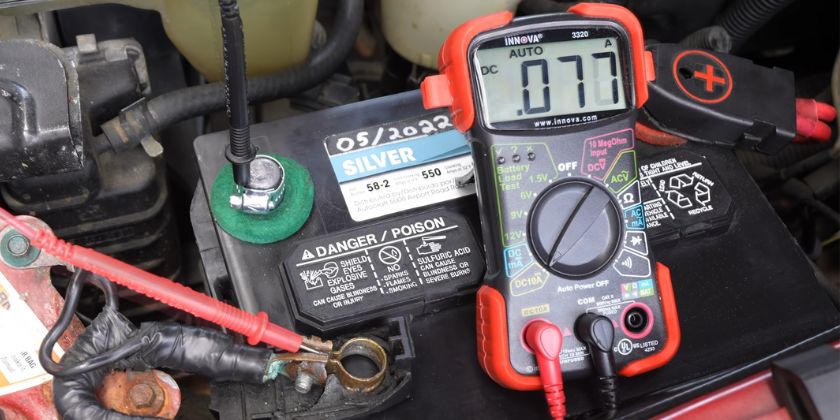
Set the multimeter to DC Amp mode.
After that, connect the negative probe to the negative battery cable and the positive probe to the negative terminal. The reading on the multimeter should be 0.5-0.7 Amps.
If it’s 1 Amp or higher, it means a car component is drawing some power from the battery.
To find out the culprit, leave the multimeter cables connected and pull out different fuses one by one while monitoring the multimeter readings.
If you pull out a fuse and the multimeter reading drops, it’s a sign that the component corresponding to that fuse is drawing power from the battery.
There will be rare instances where you check all of the fuses and can’t find the problematic component.
In that case, you’ll need to temporarily disconnect the alternator charging cable from its terminal.
If that amp reading drops, it means the alternator was draining your battery.
Yes, it’s quite rare, but a faulty diode in the alternator’s rectifier allows the current to flow back to the alternator, draining the battery.
4. Check the Serpentine Belt
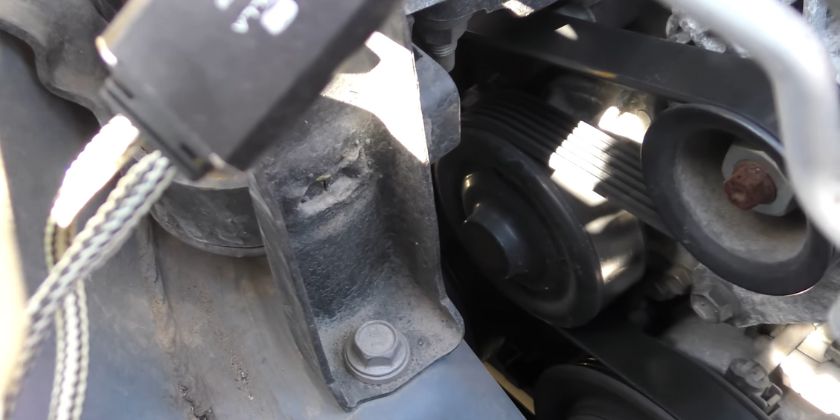
The serpentine belt is a long-sized rubber belt that drives multiple components in a car, such as the alternator, power steering pump, A/C, etc.
It does so by transferring the mechanical power from the engine’s crankshaft to those components.
If this belt is loose or damaged, it’ll not drive the alternator, causing it not to run. As a result, the alternator will not charge the battery, causing it to drain.
On the other hand, the ECU will detect this as a problem with the battery, triggering the service battery charging system warning message.
5. Check the Belt Tensioner
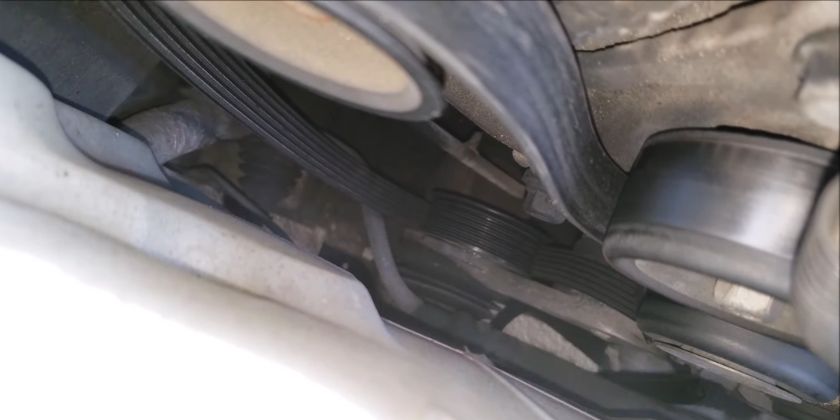
Another component that can cause the alternator not to charge the battery is the belt tensioner.
It’s a component that pulls the serpentine belt to ensure that it has the right amount of tension to drive different components (including the alternator) efficiently without slipping.
The reason we need a separate component to adjust the serpentine belt’s tension is that it can wear out over time, which can make it stretchy and lose tension.
The belt tensioner automatically adjusts the tension to compensate for this wear, keeping the belt tight enough to function correctly.
However, if this tensioner goes bad, the serpentine belt will get loose and will not efficiently drive the accessories it’s meant to.
Therefore, if the battery, alternator, and serpentine belt are in good shape, it’s time to check the tensioner.
A common symptom of a bad tensioner is a squealing or chirping noise coming from the belt area. This noise is often more noticeable during engine startup or when accelerating.
For a better understanding, watch this video blow:
6. Check the Battery Fuse
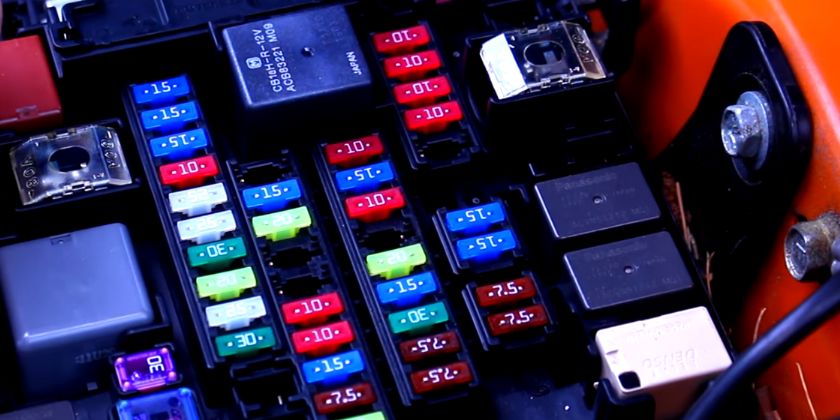
Although it’s rare, sometimes a blown fuse can cause the service battery charging system warning.
There are multiple battery-related fuses in the GMC Acadia vehicles that can blow in the event of an electrical overload.
Why?
That’s because when a fuse blows, it opens up that circuit, meaning no electricity can flow through it.
The same goes for the battery. If any of the battery fuses is blown, it’ll not receive the current and, as a result, won’t work.
Therefore, check your Acadia models fuse box diagram, locate those fuses, and test them one by one with a multimeter. If any of them is blown, replace it with a new fuse of the same amperage.
7. Check the Battery Current Sensor
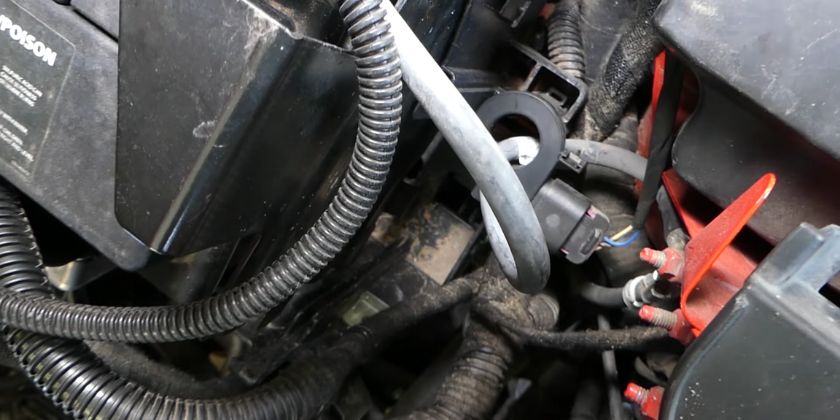
Many GM vehicles (including the GMC Acadia) come with a battery current sensor.
Installed on the battery’s negative cable, it measures the amount of current coming in and out of the battery and sends that information to the ECU.
On the basis of this information, the ECU determines whether the battery is in good condition or not.
If this sensor malfunctions, it can send incorrect information to the ECU, leading the latter to believe that the battery is not working – even though it is working fine.
As a result, you get the service battery charging system light.
Therefore, if the battery, alternator, and their connections are working, you should replace this sensor and see if there’s any change.
Fortunately, it’s not an expensive job as this sensor costs less than 20 bucks.
Conclusion
These are the seven major reasons for the service battery charging system message in your GMC Acadia.
If you’ve applied all of these methods and the message is still there, I recommend consulting the dealership, as it looks like an ECU problem.
Frequently Asked Questions
What are the Symptoms of a Bad Alternator?
Some common symptoms of a bad alternator include a dead car battery, dimming/flickering headlights, a burning rubber smell from the engine bay, whining noises from the engine bay, the car dying after a jump start, etc.
Can the Alternator Affect the AC?
As the vehicle components, such as power locks, windows, air conditioning, internal lighting, etc., rely on the alternator for the power when the engine is running, a failing alternator can cause the A/C not to work.
Is it Safe to Drive My Car With the Service Battery Charging System Light On?
No, I won’t recommend driving with the battery light on as it can cause the vehicle to stop, leaving you isolated in a far-flung location.
Why Does the Service Battery Charging System Light In My Car Come On And Off?
If you get an intermittent battery charging system light, it means the battery and alternator are dying or have loose/corroded connections.
What if I Get The Service Battery Charging System After Replacing The Alternator?
If you get the service charging system after replacing the alternator, it either means the older alternator was not the culprit or the new one is faulty/improperly installed.
Why did I Get the Service Battery Charging System After New Battery?
If you get the service charging system after replacing the battery, it either means the previous battery was not the culprit or the new one is faulty/improperly installed.

